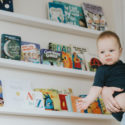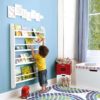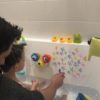We know what you’re thinking: of course you know how read a children’s book! I thought I did too…. wrong!
When Rebecca Drory, Speech-Language Pathologist and founder of Babbling Babies, shared her surprising wisdom on How to Make Storytime Meaningful, she also shared these helpful insights on how to most effectively read books (and which to choose) at each stage from newborn to pre-schooler.
For babies under 6 months: it’s all about rhythm.
Your baby is listening to melody, the rise and fall of your voice, and that’s what helps them be more in tune with you. Pretend your baby understands everything, and go for books that you personally love – Goodnight Moon, Brown Bear, Brown Bear, The Wheels on the Bus are personal favorites. This is a great time to get into a routine as it breeds a love for books early and teaches intentionality, that there is meaning behind our communication.
For babies ages 6-12 months: look for books that are as interactive as possible –and treat it almost like a toy.
Anything that enables baby to utilize multiple senses like flaps, different textures, sounds, even scratch and sniff. Let them touch, open, tap. At this age, only read word-for-word if your baby can stay engaged with you (which is rare). Otherwise, ditch the story and describe what your baby is interested in when they are turning pages, opening flaps, and looking at the pictures.
For toddlers 1-2 years: go for great illustrations and predictability.
Look for books with beautiful pictures and repetitive scripts (where the same thing happens on every page) or that are routine based (where the sequencing is easily understood, such as an animal that takes a bath or a child that is getting dressed). That predictability and patterning allows them to anticipate what’s going to come next in the story, making it easier for them to understand the vocabulary inside the book, which then leads to saying these words on their own. Using action words like “open” every time your child opens a flap and “turn” every time you turn the page can be just as beneficial as reading the actual words in the book. Where’s Spot? Dear Zoo and The Very Hungry Caterpillar are classics for good reason.
For preschoolers 2-4: Be in tune with your child’s interests and use these topics to keep them engaged.
Take them into the bookstore (or an online book retailer or library) and let them choose what’s interesting to them. If they’re into planets, buy books on planets. This is where you can start to read word-for-word again, but make sure you pause often to give your child a chance to take an active role in “reading” with you.
It’s helpful to ask open ended questions such as “what do you think will happen next to Mr. Piggy?” or “I wonder how Freddy the Moose feels about losing his tooth…”….before you turn the page. Their role can be filling in the blanks, pointing out something interesting in the pictures, or having a conversation that relates the story to their own life (“Remember when you went and had a sleepover at Grandma and Grandpa’s house just like Froggy here?”) You’ll have more meaningful conversations because they’ve already bought into the topic and can relate to the experience.
Photo: Scarlet O’Neill






